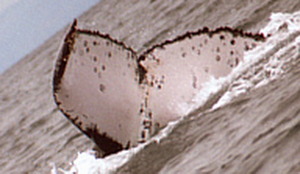Two things I love the most about citizen science are:
- science starts with an observation.
- Humans spend a good percentage of time “observing.”
That means average citizens might be observing phenomenon that scientists are looking for every day. Tapping into non-scientists’ observations has great potential to advance science and lead to interesting questions.

From Wikipedia
Case in point: When Freddy Johansen, a tourist on a whale watching boat, took a photo of a humpback whale off the coast of Madagascar in 2001, he had no idea it would break a record for these long distant travelers. Because back in 1999, researchers had photographed the same whale. However, that photo was taken off the coast of Brazil. That’s a 9,800 kilometer journey at least and more than twice the distance of the typical seasonal migration! The previous record sat near 9,400 kilometers.
Additionally, this whale was a female. This is surprising because female whales travel much shorter distances than males, and the only other humpback known to travel from the South Atlantic Ocean to the Indian Ocean was male.
This new record has researchers questioning how much we really know about whales. Some scientists are wondering if this indicates that migration patterns are changing in response to the previously endangered species’ recovery. From Nature News- Humpback Whale Breaks Migration Record:
Daniel Palacios, an oceanographer at the University of Hawaii at Manoa, says … Behaviours often change as population densities grow; for instance, animals may disperse to avoid competition for food…
The female could have been following prey, exploring new breeding habitats, responding to distant calls, or simply wandering astray. “We generally think of humpback whales as very well studied, but then they surprise us with things like this,” Palacios says. “Undoubtedly there are a lot of things we still don’t know about whale migration.”
Now you might be wondering why everyone is talking about this now when the photos were taken in 1999 and 2001. Are scientists really that inefficient? Not quite.

Spot patterns on whales' tails can be used like human fingerprints to identify individuals. Photo taken by Freddy Johansen
Back in 2001, Freddy Johansen didn’t know about the Atlantic Humpback Whale Catalog that researchers use to compare photographs of spot patterns on whales’ tails and determine if they are of the same whale at different locations. However, he did recently upload his photo to Flickr where one whale researcher (Gale McCullough of Allied Whale: see her comment below!) often checks for such photos. Connecting these two photos lead to this record-breaking discovery and Freddy Johansen becoming a coauthor on a scientific paper.
Pretty cool if you ask me, and if you have any clear photos of whales’ tails like the one above, you can also submit them to the Atlantic Humpback Whale Catalog. I wonder what other types of photos could be floating around the internet or in someone’s scrapbook with the potential to change what we know and make a scientist out of an unsuspecting citizen.
Quick Update 2:
Not only did the internet allow Gale McCullough to find Freddy Johansen’s photo, it allowed Freddy and Gale to find what I wrote! They both commented below, so be sure to check out the link to Freddy’s photo on Flickr with his retelling. Also, take a look at the comments on his photo and get a glimpse of how the story unfolded!
Gale also provides a great background story and explains how all the pieces fell into place for this discovery (read the first comment on the photo).
Read Full Post »





